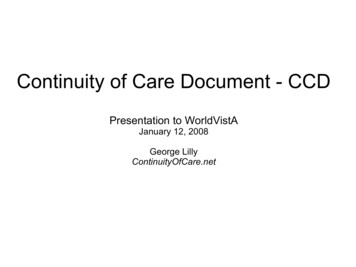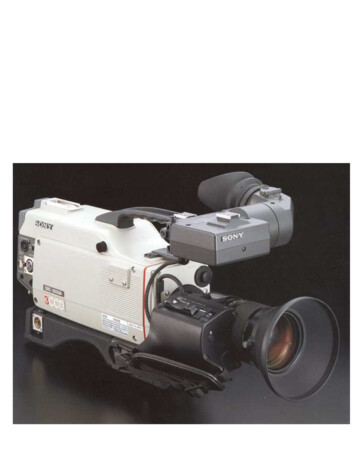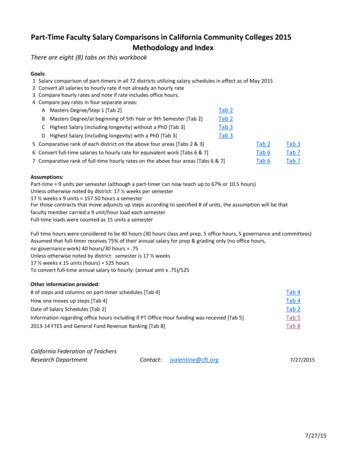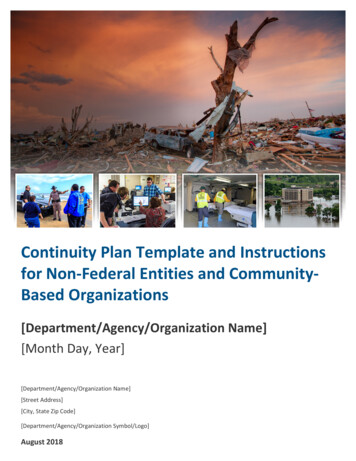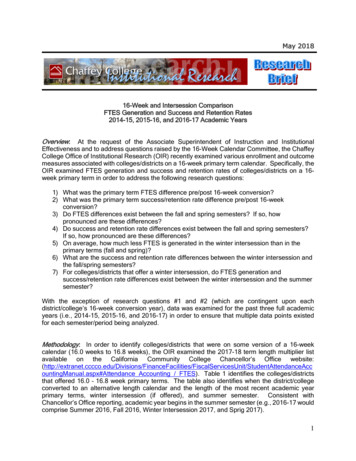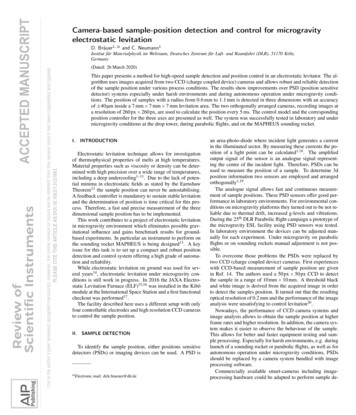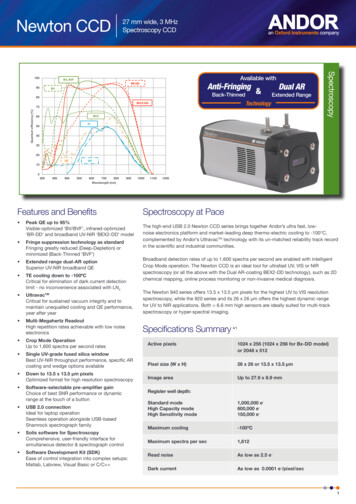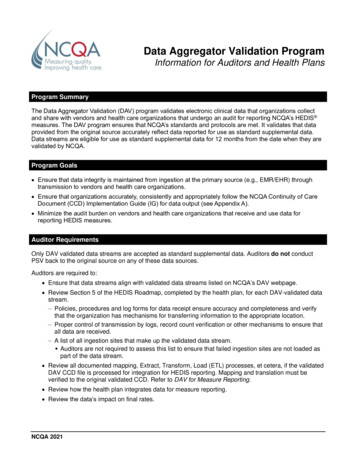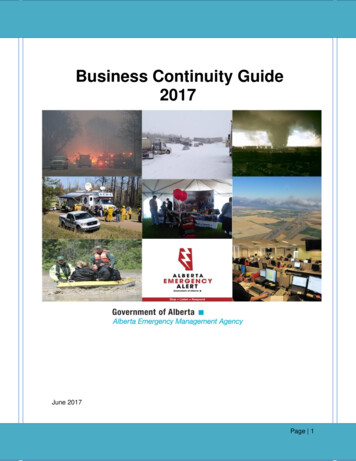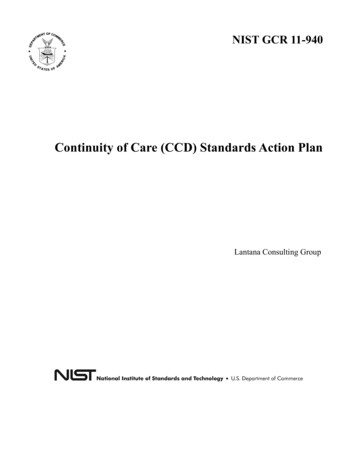
Transcription
NIST GCR 11-940Continuity of Care (CCD) Standards Action PlanLantana Consulting Group
NIST GCR 11-940Continuity of Care (CCD) Standards Action PlanPrepared forNational Institute of Standards and TechnologyGaithersburg Md 20899-8202ByLantana Consulting GroupJune 2011U.S. Department of CommerceJohn E. Bryson, SecretaryNational Institute of Standards and TechnologyPatrick D. Gallagher, Under Secretary for Standards and Technology and DirectorThis publication was produced as part of contract SB1341-10-CN-0085 with the National Institute of Standards andTechnology. The contents of this publication do not necessarily reflect the views or policies of the National Institute ofStandards and Technology or the US Government.
Continuity of Care (CCD)Standards Action PlanJune 2011Prepared by Lantana Consulting GroupforNational Institute of Standards and Technology 2011 Lantana Consulting GroupAll rights reserved.
Lantana Consulting GroupPO Box 177East Thetford, VT 05043www.lantanagroup.comLiora AlschulerChief Executive Officerliora.alschuler@lantanagroup.comBob Dolin, MD, FACPPresident and Chief Medical Officerbob.dolin@lantanagroup.comLauren Wood, Ph.D.Senior Project Managerlauren.wood@lantanagroup.comGaye Dolin, RN, MSNSenior Nurse Informaticistgaye.dolin@lantanagroup.comJingdong Li, MDChief Architectjingdong.li@lantanagroup.comYan HerasSenior Medical Informaticistyan.heras@lantanagroup.comBob YenchaPrincipal Consultantbob.yencha@lantanagroup.comSusan HardySenior Technical Editorsusan.hardy@lantangroup.comLantana Consulting Group CCD Standards Action Plan June 2011Prepared for NISTPage 4 2011, all rights reserved
Table of ContentsEXECUTIVE SUMMARY. 4INTRODUCTION. 5RECOMMENDED ACTIONS. 6Testability. 6Testing and Validation. 6Error Handling. 7Certification. 7Documentation. 8CONCLUSIONS. 9REFERENCES. 10ACRONYMS AND ABBREVIATIONS.11Lantana Consulting Group CCD Standards Action Plan June 2011Prepared for NISTPage 5 2011, all rights reserved
Executive SummaryThis document is the action plan to improve the suitability of Health Level Seven (HL7)Continuity of Care Document (CCD) to support the Department of Health and Human Services’Stage 1 Meaningful Use. Lantana Consulting Group prepared this report for the NationalInstitute of Standards and Technology (NIST) to accompany the related “CCD SuitabilityAnalysis”.We believe that CCD addresses its intended purpose to provide a snapshot in time of a patient’spertinent clinical, demographic, and administrative data. We believe CCD—with its underlying,stable HL7 Clinical Document Architecture (CDA) standard—will support the overallMeaningful Use goal of achieving significant improvements in care. In our analysis, we identifiedimprovements in testability, testing and validation, error handling, and certification that canenhance the adoption of CCD. In addition, improved documentation from the CDA Consolidationproject will mitigate some of the problems presented by layered C32 and IHE constraints. Herewe recommend actions to address these improvements.We recognize that testability, testing and validation will benefit from the investment of softwaredevelopment and policy decisions. There is work to be done to enrich an already strong standardby improving tools and processes. If acted upon, these recommendations will improve CCD’sability to support Meaningful Use.Lantana Consulting Group CCD Standards Action Plan June 2011Prepared for NISTPage 6 2011, all rights reserved
IntroductionThis document is the action plan to improve the suitability of Health Level Seven (HL7)Continuity of Care Document (CCD) to support the Department of Health and Human Services’Stage 1 Meaningful Use. Lantana Consulting Group prepared this report for the National Instituteof Standards and Technology (NIST) to accompany the related “CCD Suitability Analysis”1.This plan contains recommended actions for all issues identified in the “CCD SuitabilityAnalysis”. We also consider the interdependence between the recommended actions. Resolutionof these issues will enrich an already strong standard by improving tools and processes toencourage more widespread adoption of the CCD standard.We do not duplicate our analysis in this document, but do refer to it wherever applicable. Thisreport does not discuss assignment of responsibility for management of change process.Any mention of commercial products or organizations in this report is for information only; itdoes not imply recommendation or endorsement by Lantana or NIST.1Both CCD reports were prepared under contract SB134110CN0085.Lantana Consulting Group CCD Standards Action Plan June 2011Prepared for NISTPage 7 2011, all rights reserved
Recommended ActionsWe recommend five categories of actions: testability, testing and validation, error handling,certification, and documentation. Testability will be improved as model-driven ClinicalDocument Architecture (CDA) development techniques, such as those described in “TemplatedCDA: Key Concept for Interoperability,”2 evolve. Model-driven development will improve ourability to generate schematron and other testing and validation artefacts. Improved error handlingprocesses will help ensure that errors are corrected at the source, such that revisions cascade to alldown-stream artefacts. Certification of implementers in CCD as well as CDA will improve theconsistency of technical implementations. Improved documentation, particularly the creation ofan implementation guide that flattens the multiple layers of indirection across multipledocuments, can dramatically lower the learning curve.TestabilityTestability of the CCD standard will be improved by refining its conformance statements asrecommended in the “CCD Coverage Report”3 and by creating a template library as described in“Templated CDA: Key Concept for Interoperability”. We recommend the following actions:Re-write CCD conformance statements into multiple discrete conformance statements withconsistent style, each of which are individually testable.Develop a standard style of prose guidance when discrete testable conformance statement(s)require additional guidance for untestable real-world requirements.Create a computable template library.The CDA Consolidation Project4 is addressing issues with conformance and testability. If CCDadopts this consistent approach, it will simplify the definition of what is testable and therequirements for validation and run-time validation versus certification.Templated CDA is a key technology underlying CCD and other HL7 CDA implementationguides. Such template libraries support both standards development and implementation. Atemplate library will improve quality assurance, consistency, and schematron testing.Testability and testing improvements will develop hand-in-hand when conformance statementsare written with discrete computable testable syntax.Testing and ValidationSchematron validates syntax at several different levels of syntactic correctness. Implementers relyon schematron to determine the correctness of a CCD instance generation. A better reviewLantana Consulting Group. Templated CDA: Key Concept for Interoperability, May 2011. Relateddocument prepared for NIST.3Lantana Consulting Group. CCD Coverage Report, May 2011. Related document prepared for /CDA Consolidation Project2Lantana Consulting Group CCD Standards Action Plan June 2011Prepared for NISTPage 8 2011, all rights reserved
process for schematron rule development and creation of a reference implementation willimprove testing and validation. We recommend the following actions:Develop and publish schematron rules along with the CCD standard revisions. Any off-the-shelfXML tool can then apply these schematron rules to validate CCD instances.Establish a healthcare information technology (HIT) community review and consensus process aspart of the development of schematron rules, so that they can be publicly vetted.Consider other testing technologies to improve instance testing as identified in the “CCDCoverage Report” such as model-driven validation and RELAX NG.Create a CCD reference implementation. A reference implementation could be built to thecurrent specification; it should then be enhanced with subsequent CCD versions as part of testingand validation of new or versioned templates.Improve vocabulary validation. When a system receives a CCD instance, it must validate thestructural correctness of the instance and whether a correct code is received for a coded dataelement. Codes from dynamic vocabulary bindings are difficult to validate and require interfacewith terminology services. Health care often uses dynamic value sets to support new knowledgeand to supply missing terms. A terminology service such as one based on the HL7 Version 3Standard: Common Terminology Services, DSTU Release 2)5 would mitigate this testing problem.See the “CCD Coverage Report” for full discussion of this issue.Error HandlingHL7 has a well-defined error-handling system. Errors for base CCD are handled within the HL7community on errata pages and by the Structured Document Work Group meetings. Werecommend creation of a coordinated cross-organization error handling process for C32.CertificationHL7 provides one type of certification for the professionals who work with the CDA, but there isno certification for CCD. We recommend the following actions: Create a certification for proficiency in CCD/C32. Create several depths to the certification program so that it can be tailored to differentroles/job types.Certification overlaps with all recommendations in that updates in the CCD standard and relatedtools will have to be reflected in any certification programs.HL7 Version 3 Standard: Common Terminology Services, DSTU Release s/dstu/2009may/V3 CTS R2 DSTU 2009OCT.pdf5Lantana Consulting Group CCD Standards Action Plan June 2011Prepared for NISTPage 9 2011, all rights reserved
DocumentationCCD/C32 places multiple layers of constraints on top of CCD and presents a barrier to adoption.We recommend flattening that stack and improving its documentation to present a single resourcefor implementers of CCD/C32:Reconcile (resolve ballot comments) and publish the HL7 CDA Consolidated ImplementationGuide (currently in ballot).Harmonize discrepancies across HL7, IHE, and Healthcare Information Technology StandardsPanel (HITSP) and ballot the remaining CCD/C32 and applicable C83 modules in version 2 ofthe HL7 CDA Consolidated Implementation Guide.Ensure template changes are tracked and noted so implementers can quickly locate wherechanges need to be made in existing CCD/C32 implementations.Augment the HL7/IHE Health Story Consolidation Project with new templates supporting newuse cases and common document types.Lantana Consulting Group CCD Standards Action Plan June 2011Prepared for NISTPage 10 2011, all rights reserved
ConclusionsThe CCD standard fulfills its purpose and satisfies the criteria we defined for suitability forMeaningful Use. CCD is robust because of the underlying well-accepted HL7 CDA standard andthe ability to represent data elements in a consistent manner through vetted templates. The areasidentified in this action plan, if acted upon, will further strengthen the standard, increase the rateof implementation and prepare it for the future.Testability, testing, and validation will require an investment of software development and policydecisions. Authoring and testing tools are in development, but need to be enhanced and to matureto meet all of the HIT standards industry needs for CCD and other CDA implementation guides.Development of a single CCD/C32 resource for implementers is in progress; it requiresparticipation and support of stakeholders to see the project through to completion. A process forerror handling inclusive of C32 requires cross-organization policy and process coordination.In summary, these steps can enrich an already strong standard by improving tools and processesto increase its validity and reliability in communicating patient information in a uniform,consistent manner between healthcare organizations.Lantana Consulting Group CCD Standards Action Plan June 2011Prepared for NISTPage 11 2011, all rights reserved
ReferencesCDA Consolidation IF/CDA Consolidation ProjectHL7 Version 3 Standard: Common Terminology Services, DSTU Release s/dstu/2009may/V3 CTS R2 DSTU 2009OCT.pdfDepartment of Health and Human Services. Health Information Technology: Initial Set ofStandards, Implementation Specifications, and Certification Criteria for Electronic HealthRecord Technology; Final Rule, 45 CFR Part 170. dfDepartment of Health and Human Services. Medicare and Medicaid Programs; ElectronicHealth Record Incentive Program; Final Rule – Stage 1 Meaningful Use Objectives, 42 CFRParts 412, 413, 422 et al. pdfHL7 Implementation Guide: CDA Release 2 – Continuity of Care Document (CCD): A CDAimplementation of ASTM E2369-05 Standard Specification for Continuity of Care Record (CCR) April 01, 2007 available through HL7: http://www.hl7.orgLantana Consulting Group. CCD Coverage Report, May 2011. Related document prepared forNIST.Lantana Consulting Group. Continuity of Care Document (CCD) Suitability Analysis, May 2011.Related document prepared for NIST.Lantana Consulting Group. Templated CDA: Key Concept for Interoperability, May 2011.Related document prepared for NIST.The S&I Framework Initiative: CDA Consolidation Project.http://wiki.siframework.org/CDA Harmonization WGLantana Consulting Group CCD Standards Action Plan June 2011Prepared for NISTPage 12 2011, all rights reserved
A c ro n y m s a n d A b b re v i a t i o n sCCDContinuity of Care DocumentCCRContinuity of Care RecordCDAClinical Document ArchitectureHITHealthcare Information TechnologyHITSP Healthcare Information Technology Standards PanelHL7Health Level SevenIHEIntegrating the Healthcare EnvironmentITInformation TechnologyMUMeaningful UseNISTNational Institute of Standards and TechnologySDOStandards Development OrganizationLantana Consulting Group CCD Standards Action Plan June 2011Prepared for NISTPage 13 2011, all rights reserved
This document is the action plan to improve the suitability of Health Level Seven (HL7) Continuity of Care Document (CCD) to support the Department of Health and Human Services' Stage 1 Meaningful Use. Lantana Consulting Group prepared this report for the National Institute
